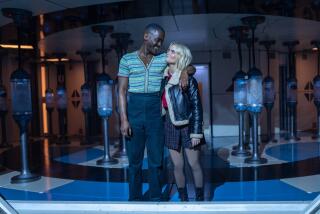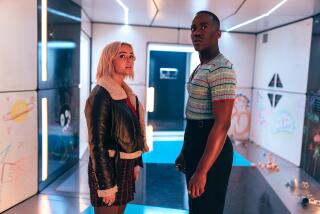Review: ‘The Day of the Doctor’ marks 50 years of ‘Doctor Who’
- Share via
A correction has been added to this post, as indicated below.
Before we begin, I should say that there will be a lot of spoilers ahead and also not a lot of technical explanation.
The 50th anniversary of “Doctor Who,” the world’s longest-running science-fiction series — in this timeline and universe, at least — has come and gone, leaving in its wake “The Day of the Doctor,” a brand-new episode full of old friends and fresh possibilities to dream on and discuss.
The next-to-last episode to feature Matt Smith in the ever-revolving, ever-evolving role of the regenerating, time-space-traveling Time Lord, it also offered a brief glimpse of his successor, Peter Capaldi — the 12th or 13th Doctor, depending on how you figure it.
PHOTOS: A first look at ‘Day of the Doctor’
It was simulcast Saturday in 75 countries around the world and shown theatrically (in 3D) in selected cities, a global mind-join that is just the sort of thing that happens in the series itself. There are the Doctor’s onscreen friends, who love him each in her or his own way, and there are the rest of us, out here. (Some of the rest of us; I don’t wish to speak for humanity.) They give him power, just as we do.
“The Day of the Doctor” performed double duty: As the next-to-the-last episode before Smith turns into Capaldi, it carries both structural and emotional weight, moving pieces into place but also taking stock of where we are and where we’ve been. It reckoned again the meaning, or meanings, of the series, which, like the Doctor himself, has changed and stayed the same since William Hartnell first occupied the time-traveling Tardis, back in 1963.
It was also, a straight-up celebration, opening with the original black and white titles, according a nod to the junkyard where the original Tardis was parked, and giving London pride of place, to remind the watching world just whose television show this is.
In honor of this moment, Moffat brought back heart-flutterer David Tennant as the previous Doctor, linking him in a double act with Matt Smith — Smith & Tennant, the act practically writes itself — in a kind of “The Road to Gallifrey,” by way of Elizabethan England. The Zygons, unseen in their true form in this century, were the shape-shifting villains of the piece — though not so much the villains, as a distraction from the main business of the episode: repairing the Doctor himself.
VIDEO: Behind the scenes of ‘Doctor Who’
And then there was John Hurt, introduced in the last minute of “The Name of the Doctor” — a heretofore unpictured, unnumbered Doctor who would come between Paul McGann’s Number Eight and Christopher Eccleston’s Number Nine — as the Doctor who pushed the button that ended the Time War, destroyed his people, and broke him all at a stroke.
It was a great episode, I thought, silly and lovely by turns, full of great lines, most of which would wither out of context (“Regeneration, it’s a lottery” — classic!), with the temporal chutes and ladders and four-dimensional farce that have marked current show runner Steven Moffat’s scripts since he was writing for former show runner and “Who” re-originator Russell T. Davies. (Here he thinks up clever things to do with Time Lord paintings). There were riffs on Tennant’s skinniness, Smith’s chin, Eccleston’s ears, sonic screwdrivers, timey-wiminess, big red buttons and the roundels in the walls of the Tardis.
And there was Billie Piper too, not in her old role as 10th Doctor companion Rose Tyler, exactly, but the living expression of a weapon so advanced that it had developed a conscience. (As she was seen only by Hurt, fans were denied a last, or another last, romantic moment with Tennant; as close as they came was a shared two-shot.) And most miraculously, there was Tom Baker, who played the Fourth Doctor, walking in at the end, when the hurly burly was done, possibly as the Doctor’s older self, and possibly as his younger, and maybe neither.
“I never forget a face.” says the Smith Doctor, who could and couldn’t place this one.
“I know you don’t,” said Baker. “And in years to come you might find yourself revisiting a few — but just the old favorites, eh?”
PHOTOS: Behind the scenes of movies and TV
The scene had no practical purpose; it was just a moment of poetry. Just so, there was no explanation necessary when, at the climax of the episode, Moffat drafted every incarnation of the Doctor, including one to come, to save Gallifrey by freezing it in time and afterward lined them up, literally, in a line, as a child would arrange his action figures.
Or merely this: It was because the heart of the show is the history of the show. “Doctor Who” lives both on the screen and in the community of generations who have made it real. It’s a series made by such people, for such people: a show you can not only love but that loves you back.
[For the record, Nov. 26, 10:14 a.m.. A previous version of this post stated that John Hurt appearing in the last minute of “The Day of the Doctor”; it was “The Name of the Doctor” in which he first appeared.]
More to Read
The complete guide to home viewing
Get Screen Gab for everything about the TV shows and streaming movies everyone’s talking about.
You may occasionally receive promotional content from the Los Angeles Times.







